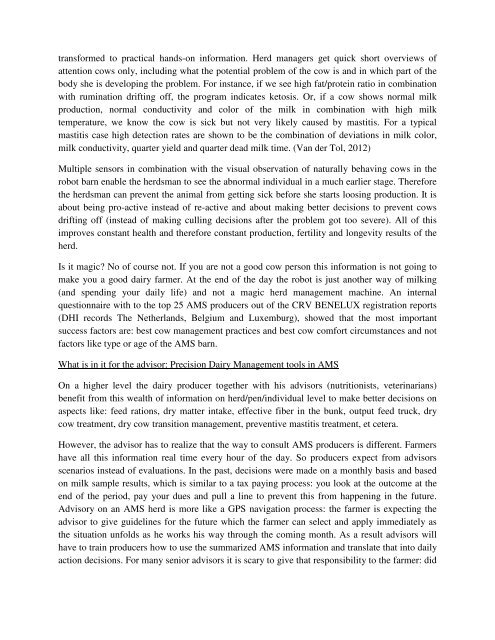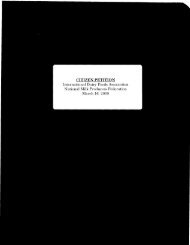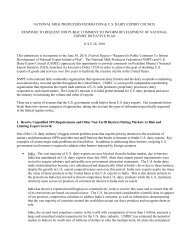Ben Smink - National Milk Producers Federation
Ben Smink - National Milk Producers Federation
Ben Smink - National Milk Producers Federation
Create successful ePaper yourself
Turn your PDF publications into a flip-book with our unique Google optimized e-Paper software.
transformed to practical hands-on information. Herd managers get quick short overviews of<br />
attention cows only, including what the potential problem of the cow is and in which part of the<br />
body she is developing the problem. For instance, if we see high fat/protein ratio in combination<br />
with rumination drifting off, the program indicates ketosis. Or, if a cow shows normal milk<br />
production, normal conductivity and color of the milk in combination with high milk<br />
temperature, we know the cow is sick but not very likely caused by mastitis. For a typical<br />
mastitis case high detection rates are shown to be the combination of deviations in milk color,<br />
milk conductivity, quarter yield and quarter dead milk time. (Van der Tol, 2012)<br />
Multiple sensors in combination with the visual observation of naturally behaving cows in the<br />
robot barn enable the herdsman to see the abnormal individual in a much earlier stage. Therefore<br />
the herdsman can prevent the animal from getting sick before she starts loosing production. It is<br />
about being pro-active instead of re-active and about making better decisions to prevent cows<br />
drifting off (instead of making culling decisions after the problem got too severe). All of this<br />
improves constant health and therefore constant production, fertility and longevity results of the<br />
herd.<br />
Is it magic No of course not. If you are not a good cow person this information is not going to<br />
make you a good dairy farmer. At the end of the day the robot is just another way of milking<br />
(and spending your daily life) and not a magic herd management machine. An internal<br />
questionnaire with to the top 25 AMS producers out of the CRV BENELUX registration reports<br />
(DHI records The Netherlands, Belgium and Luxemburg), showed that the most important<br />
success factors are: best cow management practices and best cow comfort circumstances and not<br />
factors like type or age of the AMS barn.<br />
What is in it for the advisor: Precision Dairy Management tools in AMS<br />
On a higher level the dairy producer together with his advisors (nutritionists, veterinarians)<br />
benefit from this wealth of information on herd/pen/individual level to make better decisions on<br />
aspects like: feed rations, dry matter intake, effective fiber in the bunk, output feed truck, dry<br />
cow treatment, dry cow transition management, preventive mastitis treatment, et cetera.<br />
However, the advisor has to realize that the way to consult AMS producers is different. Farmers<br />
have all this information real time every hour of the day. So producers expect from advisors<br />
scenarios instead of evaluations. In the past, decisions were made on a monthly basis and based<br />
on milk sample results, which is similar to a tax paying process: you look at the outcome at the<br />
end of the period, pay your dues and pull a line to prevent this from happening in the future.<br />
Advisory on an AMS herd is more like a GPS navigation process: the farmer is expecting the<br />
advisor to give guidelines for the future which the farmer can select and apply immediately as<br />
the situation unfolds as he works his way through the coming month. As a result advisors will<br />
have to train producers how to use the summarized AMS information and translate that into daily<br />
action decisions. For many senior advisors it is scary to give that responsibility to the farmer: did









